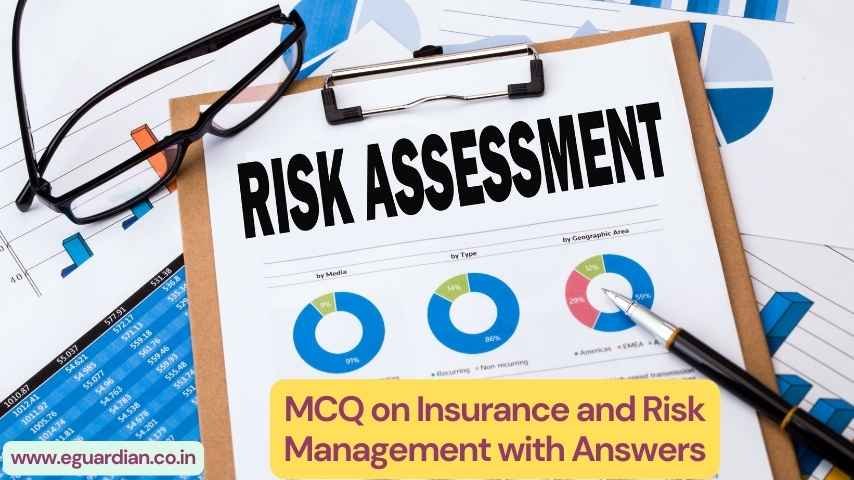MCQ on Insurance and Risk Management with Answers Practice Test for BBA, MBA, Mcom, Bcom, and other Banking & Finance exams.

MCQ on Insurance and Risk Management
1. ___ as the number of exposures increases.
Answer: Objective risk
2. ___ increases the frequency of loss.
a) Peril
b) Subjective risk
c) Hazard
d) Objective risk
Answer: (c)
3. An earthquake happens due to a hazard present. (True/False).
Answer: False
4. ___ hazard increases the probability of loss due to dishonesty or character defects of an insured person.
a) Moral
b) Morale
c) Legal
d) Physical
Answer: (a)
5. ___ has an inherent tendency to amplify the degree of risk.
Answer: Hazard
6. ___ can be assessed.
Answer: Degree of risk
7. In ___ the outcomes can be identified with known probabilities.
Answer: Level 1 (Objective probability)
8. Uncertainty does not exist at level 1 (objective probability). (True/False).
Answer: False
9. The different degrees of uncertainty can be represented on a straight line called ___.
Answer: Continuum
10. ___ risks happen within a stable environment and are constant over an observed period of time.
a) Speculative
b) Pure
c) Dynamic
d) Static
Answer: (d)
11. Which among the following is not a pure risk?
a) Personal risk
b) Property risk
c) Loss of income risk
d) Strategic risk
Answer: (d)
12. The contract of insurance is usually applicable only to pure risks. (True/False).
Answer: True
13. According to the holistic view, risk management must only cover insurable risks. (True / False).
Answer: False
14. In ___ method of identifying risk it is difficult to identify the industry-specific risk, as it is general in nature.
Answer: Questionnaire
15. Evaluating the risk needs to be measured in two dimensions that is ___ and ___.
Answer: Loss frequency, Loss severity
16. Which of the following method reduces the chance of loss to zero?
a) Risk Transferring
b) Risk avoidance
c) Risk retention
d) Risk reduction
Answer: (b)
17. In ___ strategy, risks are retained in a proportion so that the overall risk is reduced.
Answer: Risk combination
18. ___ strategy involves two parties to reduce risk.
Answer: Risk transfer
19. ___ refers to the manner in which the risk control measures that have been implemented shall be financed.
a) Risk financing
b) Risk retention
c) Risk transfer
d) Risk sharing
Answer: (a)
20. ___ finances the loss by retaining the operating revenues and earnings.
Answer: Risk retention
21. ___ is transferred from one entity to another entity in different ways.
Answer: Risk of loss
22. ___ is a process to manage dangerous functions and policies that cause losses to an organization.
Answer: Risk management
23. ___ is the most famous tool of risk management
a) Certainty risk
b) Insurance
c) Loss prevention
d) Uncertainty risk
Answer: (b)
24. ___ is a part of the overall agenda for managing the risk and safety of a construction project.
Answer: Insurance procurement
25. In insurance, the ___ occurs in „excess-of-loss‟ or „stop-loss‟ contracts.
Answer: Pay off
26. The amount for a share that an option buyer pays to the seller is known as ___.
a) Call option
b) Put option
c) Option price
d) Send option
Answer: (c)
27. ___ offers the rights to buy a specified asset like stocks at a particular price during a specified period.
Answer: Call option
28. The main aim of the VAR approach in risk management and capital regulation is to avoid capital requirements close to the underlying risks of assets in a portfolio. (True/false).
Answer: False
29. Regulators distinguished that ___ are the risk management tools for insurance organizations.
Answer: Derivatives
30. ___ is defined as the maximum potential change in the value of the financial instruments portfolio with a provided probability for a certain time period.
Answer: Value at Risk (VAR)
31. ___ safeguards the financial segments from political risks.
Answer: Consumer protection
32. ___ is still the leading channel in India for distributing insurance products.
a) Brokers
b) Agency power
c) Insurance market
d) National market
Answer: (b)
33. The ___ division has marvelous growth potential in the insurance market.
Answer: Health insurance
34. Public insurance is also known as ___ as helps the people below the poverty line or people who cannot face their basic risks by themselves.
Answer: Social insurance
35. In a private sector company, usually the transfer of risk is done through a contract and they are voluntary. (True/False).
Answer: True
36. Involuntary insurance comes under ___ sector.
Answer: Public
37. IRDA is basically a team of eight members. (True/False)
Answer: False
38. IRDA supports competence in the insurance industry.(True/False)
Answer: True
39. IRDA is permitted to oversee the performance of the ___ Committee.
Answer: Tariff Advisory
40. ___ have to analyze risk by gathering information from various sources and writing policies to manage it.
Answer: Underwriters
41. An insurance agent represents the ___.
a) Insured
b) Insurer
c) Government
d) Adjustment bureau
Answer: (b)
42. Loss adjustors should be experts in ___ and ___ skills.
Answer: Analytical, people management
43. The only public sector life insurance company in India is ___.
Answer: Life Insurance Corporation of India
44. The ___ is formed with four subsidiary companies.
a) Life insurance Corporation of India
b) ICICI Prudential Life Insurance Company
c) General Insurance Corporation of India
d) Bajaj Allianz General Insurance Company
Answer: (c)
45. One reason for the formulation of the private sector was to give better coverage on ___and ___.
Answer: Products, services
46. According to the Malhotra committee, private companies should have an initial capital of ___ to work in the insurance industry.
Answer: Rs 1 billion
47. The Insurance (Laws) Amendment Bill 2008 was amended with the help of three other acts namely, Insurance Act 1938, General Insurance Business (Nationalisation) Act 1972, and Insurance Regulatory and Development Authority Act 1999. (True/False).
Answer: True
48. The LIC (Amendment) Bill 2009 was formed to increase the capital of LIC from ___ to ___.
Answer: Rs.5 crores to Rs.100 crores
49. Insurance regulations mainly concentrate on preventing ___.
Answer: Insolvencies
50. The basic regulations which deal with the insurance business in India are the ___ and the ___.
Answer: Insurance Act, 1938, IRDA Act, 1999
51. Protecting customers’ interest includes keeping prices affordable, having some mandatory products, and standardization of services. (True/False).
Answer: True
52. The ___ decides the head office of the authority.
Answer: Central government
53. ___ is needed for the smooth functioning of the insurance business.
Answer: Insurance regulation
54. Which of the following is not a concern of the insurance regulatory framework?
a) It has to safeguard the interests of the customers
b) It has to safeguard the interests of the stakeholders
c) It has to ensure the financial soundness of the insurance industry
d) It has to help in the healthy growth of the insurance market
Answer: (b)
55. ___ is prepared only under the Direct Method.
a) Accounting for Investments
b) Segment Reporting
c) Cash Flow Statement
d) Revenue Recognition
Answer: (c)
56. According to the IRDA Regulation, the ___ has to be identified as the income over the contract period or the period of risk, whichever is suitable.
Answer: Premium
57. According to the IT Act the ___ is deducted and deposited to the government account within the given time limit.
Answer: Tax Deductions at Source (TDS)
58. ___ are assets that the insurer gets from the income that is earned through dividends, rent interest, etc.
Answer: Investments
59. The IRDA‟s regulation for the preparation of financial statements has set some ___ for determining the value of investments.
Answer: Procedures
60. According to the ___ the foreign branch accounts which are prepared in local currencies are converted into Indian currency and merged with Indian accounts.
a) Accounting Statement 11
b) Accounting Statement 3
c) Accounting Statement 17
d) Accounting Statement 13
Answer: (a)
61. All the related party transactions, as needed by the ___, have to be compulsorily disclosed by the insurers.
Answer: Accounting standard
62. All the securities have to be transferred to the ___ Account at either cost price or market price, according to which is lower.
a) Stakeholders
b) Policyholders
c) Insurer
d) Reinsurer
Answer: (b)
63. All insurers have to maintain separate investment accounts for the ___ and the ___ as these are two separate business segments.
Answer: Shareholders and Policyholders
64. Life insurance not only protects a person from___but also is a good means of ___ for the people.
Answer: Future risks and savings
65. The purpose of life insurance is to provide ___ against the losses.
Answer: Financial protection
66. Life insurance in family life does not provide needy survivors with financial help in their grief. (True/False).
Answer: False
67. Both large and small companies insure the life of ___.
a) Managers
b) Technical Staff
c) Important employees
d) Team leaders
Answer: (c)
68. ___ is the amount of insurance payable by the policyholder.
Answer: Premium
69. The person who makes the assignment is called Assignee and the person to whom the policy is assigned is called Assigner. (True/False).
Answer: False
70. Which of these is not an element of life insurance?
a) Grace period
b) Nomination and assignment
c) Policyholder
d) Paid-up value
Answer: (c)
71. Term life insurance policy premiums are ___ than those for whole life insurance.
Answer: Less costly
72. Permanent life-insurance helps to keep the premiums the same every year and provides a guarantee of the premiums when the policy is first purchased (true or false).
Answer: True
73. Money-back policies are issued for a period of 15, 20, 25 years only. (True/False).
Answer: True
74. ___ is a whole-life policy that insures two lives with the proceeds payable on the second (later) death.
a) Survivorship life insurance policy
b) Group life insurance
c) Joint life insurance
d) Prepaid insurance
Answer: (a)
75. ___ allows people to buy higher levels of coverage at a younger age when the need for ___ is obviously more.
Term life insurance and protection
Answer: (a)
Basic Accounting MCQs with answers
Conclusion:
Mastering the basics of Insurance and Risk Management through objective questions is an efficient way to reinforce learning.
These MCQs provide a quick revision tool and help identify areas for further study. Keep practicing regularly to build confidence and accuracy in this important subject.



